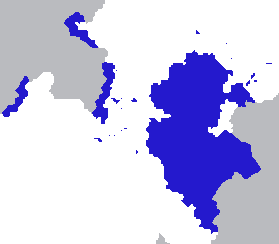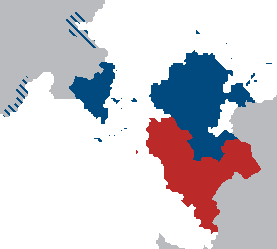Fugireu
Kingdom of Fugireu Wių́tįrą́s Fugįreuh wui´`ti`ra´`s fugi`reih | |
|---|---|
|
Flag | |
| Capital | Zaxeebi |
| Official languages | Fuggic |
| Demonym(s) | Fuggic |
| Government | Unitary parliamentary constitutional monarchy |
• King | Ozór III |
• Regulator | Seérih Hríbór |
| Legislature | Grand Beyhaight |
| Noble Beyhaight | |
| Common Beyhaight | |
Fugireu (/ˈfu:gɪɹoʊ/; Fuggic: wui´`ti`ra´`s fugi`reih Wių́tįrą́s Fugįreuh) is a country located in Northwest Yazland bordering Hepetha and Teremres.
Etymology
History
Yasgan migrations
Osturic dynasty, 1521 CY – 2013 CY

The 16th century CY would see the rise of the first Fuggic state under the rule of the Osturic dynasty. The Osturic dynasty would rise under the rule of King Fezorstóroh Ostų́r and would establish itself as the first organized kingdom in the area. Ostur would see the conquest of numerous Pre-Yasgan groups in Northern Fugireu, and would establish the traditional capital of Zaxeebi. The Osturic dynasty would become a vital trade connection between Etzavaz and Yazland in the Triangle Sea trade, becoming vital trade partners of the Dhimze. The Osturic dynasty would see its last ruler with King Beugeeturuh Seéri, who would lose the Battle of X in 2013 CY, and would see the country conquered by the Khozathian Empire.
Khozathian rule
Safiuric dynasty, 2117 CY – 2631 CY

Following the success of Safiur’s Rebellion, the Kingdom of Fugireu would be reestablished under Baséturuh Sáfiur. The Safiuric dynasty would become a powerful military force in West Yazland, conquering much of the X peninsula and expanding into modern day Hepetha. The Safiuric dynasty would come into conflict with the native pre-Yasgan peoples of Hepetha, and would end up nearly eradicating them following the brutal X war. The Safiuric dynasty would also begin the process of Fuggic colonization along the southeastern coast of Etzavaz, frequently coming into conflict with the native Etzavazi peoples and establishing trade cities along the coast.
Two kingdoms period

Following the death of King Euyezęh Ką́zoma, the Safiuric dynasty would be split into two kingdoms. Ką́zoma intended this as a compromise between his two sons, and hoped it would prevent a future civil war over the kingdom. Ką́zomah Gį́ríyo would become king of Hepetha while Ką́zomah Nixigį́ would continue to rule in Fugireu, becoming the Nixigic dynasty. In addition, Fuggic control over the various Etzavazi colonies would begin to wane, as various colonial settlements began to make their own independent decisions outside the monarchy's influence. The peace Ką́zoma had hoped to create would not last, as the two brothers, having grown separated over the years, came to blows multiple times over the independence of Hepetha. The Two Kingdoms period would end following the death of Nixigį́ I in battle against Gį́ríyo, after which the independence of Hepetha would be secured, and Gį́ríyo would abdicate in favor of his heir.
Giriyic dynasty 2636 CY – 2773 CY
Gį́ríyoh Dézeér would succeed Gį́ríyo as king of a largely united Fuggic mainland, however, remnants of the Nixigic dynasty would persist in Fuggic settlements across southern Etzavaz. Takuruh Zį́dǫ́, one of Nixigį́’s most trusted advisors, would be posthumously adopted by the dead king, continuing the Nixigic dynasty. The continued existence of the Nixigic dynasty would lead to a long series of on and off wars between the Giriyic dynasty and the Nixigic dynasty, known as the Two Scores’ War. Primarily fought over sea, the conflict would be one of the longest in Fuggic history, coming to a close following the overthrow of the Nixigic dynasty by the local Fuggic lords in Etzavaz. The following civil war in lands formerly belonging to the Nixigic dynasty would be long-lasting, and the nobility of mainland Fugireu would not regain control of it until X. The Giriyic dynasty would end with the death of the young king X, who died in battle against the Teremish lords to the east, sending the kingdom into a brief chaos.
Wonuric dynasty, 2773 CY – 3287 CY
Following the death of X, the nobles of Fugireu would be thrown into a brief disorder. They were united following the Council of Zaxeebi, where Wonur Teniyǫh would lay claim to the throne in exchange for increased privileges for the local nobility. This would lead to the establishment of the position of Regulator, elected by the nobles, who would gather together in the Beyhaight (Fuggic: be´he´ht béhéht “gathering”).
